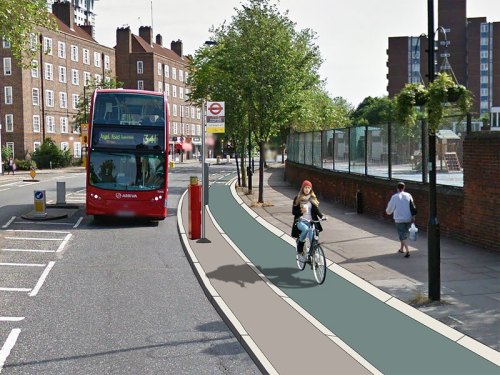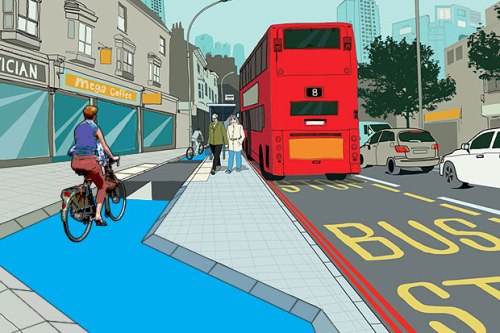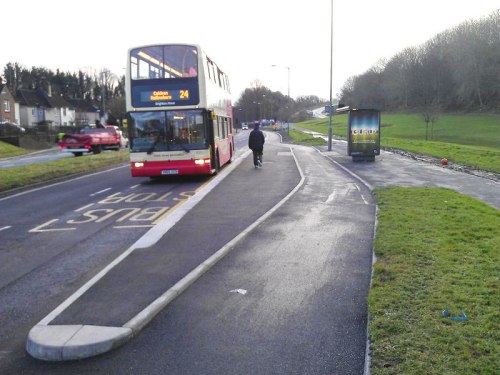I wrote much of this post ages ago, but never got around to finishing it. Events have somewhat overtaken me in the meantime, with TfL announcing plans to implement this very solution! (Update, ten months later: Sadly, they botched it.)
This type of design have also been recently covered at As Easy As Riding A Bike, and David Hembrow has previously discussed this Dutch bike-friendly bus stop design too. I recommend following those two links to see excellent Dutch designs.
If you require physical, concrete proof that the authorities don’t care about cycling, take a look at a bus stop. The design will almost certainly give priority to private motor vehicles, with public transport a poor second and bikes a very distant third.
Consider this fairly standard bus stop design (although it’s lacking the yellow ‘bus stop box’ markings).
What will happen when the bus pulls in?

A bus about to block the bike lane so that cars can pass freely. (Source: Google Maps)
The bus pulls in and blocks the cycle lane, so that cars can pass freely.

The bus has pulled in to the bus stop, which blocks the cycle lane, enabling those very important cars to pass freely.
Any bike riders must wait behind…

Come on children, take the lane! Do it for the Cycling Revolution™!
…or pull out to pass the bus. (Note to any VC evangelists reading this: NORMAL PEOPLE FIND THIS TERRIFYING AND WON’T DO IT, HOWEVER MUCH YOU TELL THEM IT’S SAFE.)

People riding bikes must either wait behind the bus, or pull out to overtake it. (Overtaking a bus while riding a bike is something most people don’t ever want to do.)
This is the contempt with which the UK authorities see cycling — and buses are given second-rate status too. For not only do people riding bikes have to pull out to pass the bus (a terrifying place to be for most people) but when the bus is ready to set off it has to wait until there is a gap in traffic before it can pull out itself!
There, in one pithy design, is proof that the private car comes above all else. And it’s the standard design for bus stops in the UK, and it’s one reason why ‘normal’ people don’t ride bikes for transport. The constant leapfrogging between bikes and buses is a terrible way to organise traffic flow.
Go Dutch, go behind the bus stop
Returning back to the top photo, here’s a better alternative:

An alternative bus stop design, the likes of which are now being suggested by TfL.
This design enables people riding bikes to pass buses without having to ride around the outside of the bus in the flow of traffic. (Remember, dear Cyclists: normal people aren’t willing to do that. Like the woman calmly riding while drinking a coffee there.)
Note the shallow, angled kerbs. I’m a big fan of these. If you’re using a wheelchair or pushing a pram, they’re easier to roll across. If you’re riding a bike, running into them will cause you no harm. They’re often called ‘forgiving kerbs’ (and known as ‘splay kerbs’ to those in the trade) and they’re a tiny change which makes a big difference. (One of the major flaws of the Torrington cyclepath in central London is the high, straight kerbs which mean that you must ride well away from the edge. Making these into shallow kerbs with an angle of about 30º would enable the full width of the path to be used… but that’s another post!)
But that’s just version one. The bus stop island is too narrow for my liking, but because we’ve moved the bus stop and ticket machine onto the island there’s now space on the pavement available to move the cyclepath across, so we can make the bus island wider:

Plenty of space for people to get on and off the bus
There’s no loss of space to pedestrians, as the cyclepath would run over where the bus stop is currently located (i.e. you can’t walk there anyway due to the bus stop, ticket machine and bin). In fact, add the footpath and the bus stop island together and there’s actually more space for people on foot because the part of the road which was previously covered in stripes of paint is now the bus island!
TfL sees the light
I never thought I would praise TfL, but that is what we must do, for they have finally seen the light and realised that nearly everyone doesn’t like riding bikes amongst motor traffic. (Seems fairly obvious to me, but there you go.) Congratulations to whoever got this new design through!
More specifically to this article, they’ve realised that people don’t like overtaking buses while riding a bike. (Except for these selfish bastards, of course, but they’re extreme sports fanatics and adrenaline junkies, so we really shouldn’t base transport policy on their desires any more than we should design roads for boy racers.)
So it’s great that TfL are now planning this kind of design for the extension to Cycle Superhighway 2, and it’s the kind of thing which is normal in the Netherlands, and it works very well. Once you’re already dealing with a separate cyclepath it makes sense to put the bus stops on islands between the cyclepath and the road.
Here’s TfL’s artist’s impression of a bus bypass:

TfL’s artist’s impression of a cyclepath with bus stop bypass. Note their fast Cyclist, no doubt about to collide with those innocent pedestrians.
It’s good but not quite right for me. Note the 90º kerbs and typical London Cyclist (capital-C intentional) complete with helmet, dropped handlebars, lurid jacket and probably gritted teeth (though he’s facing away so we can’t see that). (The Cyclist looks a bit too big to me too, but never mind.)
Here’s my slightly modified version:

My amended version of TfL’s design. I also changed the cyclist to a lovely middle-aged woman who isn’t going to run anyone over. “Please, go ahead.” “No, after you!” “Why, thank-you!” “You’re welcome. Have a nice day!” Etc. etc.
Nicer kerbs for starters – really, these are essential in any modern cyclepath design. I’ve also got rid of TfL’s Cyclist and replaced him with a middle-aged female who is merely using a bike for transport. (She doesn’t know anything about bikes, nor has she ever watched the Tour de France. She’s just going down the pub.)
I’m still not keen with how the cyclepath crosses the footpath – who has priority here? For me, this could be clearer.
If pedestrians have priority then can’t we add zebra-stripes to the cyclepath, or at least a ‘pedestrian’ icon on the surface? If bike users have priority then the surface should remain blue throughout the crossing area, which will make it clear to pedestrians that they’re crossing a cyclepath. (Also, maybe the footpath should lower to the cyclepath level rather than the cyclepath rising to footpath level as in the images above.)
While you’re here…
While I’m on the subject, here’s what the Cycle Superhighway looks like at the southern end of Southwark Bridge in London:

TfL’s current solution: pull out into the stream of cars and vans to overtake the buses! (Photo: Alan Perryman)
That’s really dreadful, isn’t it? Expecting people to pull out into a lane of traffic which will be overtaking the bus? And we wonder why cycling is dominated by fit young men! (And I’m not going to talk about the awful pinch point in the distance there…)
So what would be better? Something like this:

A better way to handle buses and bikes at Southwark Bridge.
The bikepath runs along where the bus shelter was, and the bus shelter has been moved to where the bus stopping area was. The bus stop markings are now in the main carriageway, which means – shock, horror – that cars have to wait behind stopped buses while people on bikes can ride past.
Anyway, that’s all I have to say about bus stops for now.
If you like the sound of this you should respond to TfL’s consultation telling them how much you love this design.
















 The Alternative Department for Transport is written by, and the personal opinion of,
The Alternative Department for Transport is written by, and the personal opinion of, 


